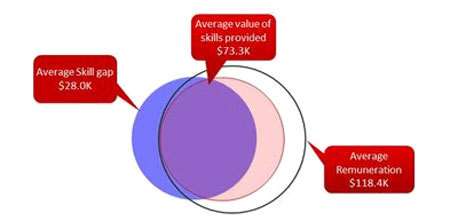After almost 50 years in the IT recruitment industry, we are constantly amazed at the ‘hit and miss’ approach many organisations have in relation to IT roles and recruitment in general.
At a recent Australian Computer Society (ACS) roundtable we discussed the challenges young people have in entering an industry where roles change so quickly in relation to other industries, and how IT graduates maintain their relevance in such a fast moving industry.
One of the recommendations was to have organisations look at the underlying skills that make up these roles, and focus on these rather than the roles.
Some prominent universities in the UK include the SFIA (Skills Framework for the Information Age) skill codes associated with each course, to assist students in career development and skills management, as does the ACS with their courses and events.
Deconstructing roles into their component skill parts does not only assist with role definition, it can significantly assist with both recruitment and the value each role provides.
At an individual level, the benefits of SFIA are obvious in that understanding the skills you have allows you easily see where you are lacking and set a path for professional development. However it is at an organisational level where the benefits of SFIA are tremendous.
Skills and salaries poorly aligned
We have just finished an interesting study where we compared the salaries and skills for a set of individuals within one of our clients. We looked at analyst programmers, business analysts and project managers that had been placed in the organisation over the past two years.
When we look at the correlation between skills and salaries of the individual, there is poor alignment. The graph below has the salaries on the left and the skills alignment on the right.

First of all there was a variation in the salaries paid for the types of role, which could be as high as an additional 30 per cent. And secondly, there were many roles where the required skills were absent, although the salary of the successful candidate remain unchanged. This led us to consider a number of different scenarios that could explain the difference in alignment between salary and skills.
- Scenario 1: Work being performed by another individual.
In this case, the skills required to perform the work are present in another individual, and they are performing the activities associated with the role. In this case, there is a hidden cost which has been transferred to another person.
- Scenario 2: The activities associated with the skill are not being performed adequately.
This is most often the case, and in the case of the project managers in the case study, this would result in poor risk management with regards to the project, a lack of skill with benefits management and business case management, and poor change planning. This also becomes a risk issue, and there are a number of audit findings that could be applied. The COBIT 5 controls APO05 (Manage Benefits Achievement), APO07 (Manage Contract Staff) and EDM04 (Ensure Resource Optimisation) all relate to skills and capabilities. APO05 and APO07 reference SFIA directly as related guidance. - Scenario 3: Skills were not really required in the first place.
This is the most unlikely outcome, as why would an organisation include a requirement for a skill that was not really required? If this is the case, then the role should be re-scoped and the skill removed.
Translating missing skills into value
On average, there was $28K worth of skills missing in each role we assessed, and $73.3K worth of value being provided. The average salary for each role should be $101.3K, but the actual average remuneration is $118.4, a difference of $17.1K.
Therefore, the combined saving if a person was aligned to each role would be $45.1K. To put it into perspective, with an organisation of 1,000 IT staff, the saving would be $45M per annum, or approximately 31 per cent.

Skills help embed best practice
There is great value in adopting frameworks like ITIL, Prince2, COBIT and the like to standardise on process and implement good governance. Unless we define the roles that support these frameworks effectively, then people will be challenged in performing their tasks and being effective in their roles.
By implementing a skills framework like SFIA, we can better align the skills required for the roles we build, and justify the cost of skills development and career progression. If we understand the value of a skill or set of skills, we can choose whether to build the capability ourselves or buy it in. We can track where our human assets are, and calculate the return on our human capital.
Finally, by aligning the roles people have to the skills they require, we are much more likely to get them to adhere to the processes they need to follow. SFIA is truly the missing or forgotten framework, and a critical component to both embedding and delivering IT governance.
If you are interested in reading the full white paper, then please email me and I will pass it on. My email address is Consulting@adaps.com.au
SFIAplus is the industry standard IT skills and competency framework targeted specifically at organisations looking to professionally develop their IT functions. BCS enables organisations to conduct a complete skills audit, identify talent and create career paths for their IT professionals.
To find out about using SFIAplus within your organisation contact BCS.












